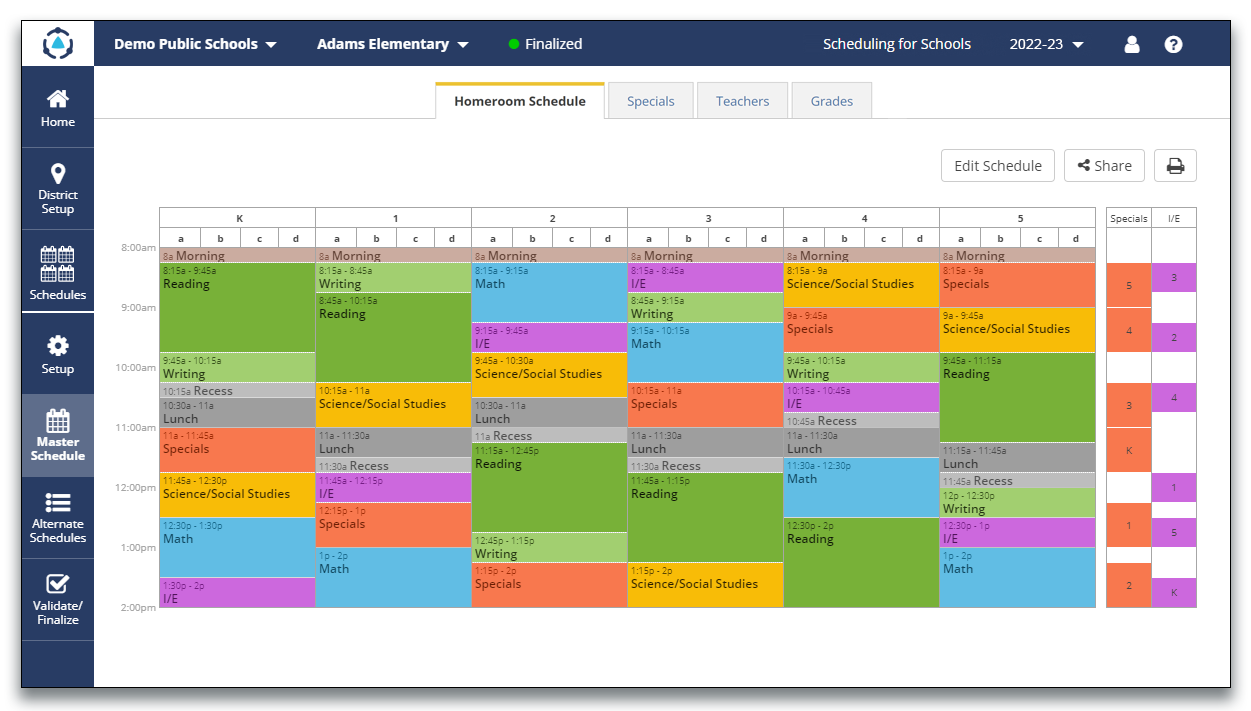
Building an Elementary Schedule - Part 8: Scheduling Remaining Periods
This 12-part series on How to Build an Elementary School Schedule offers step-by-step guidance and proven scheduling strategies for creating a better elementary school schedule.
As of now, you have completed the most critical items on your schedule. You have efficiently scheduled specials, managed lunch and recess constraints, strategically scheduled ELA and Math, and scheduled daily intervention/enrichment periods to ensure all students get the support they need.
While you're not yet done, you're off to a good start. When you schedule remaining periods, make sure you don't undo all the strong decisions you've already made. As you schedule the rest of the school day, consider the following:
Science and Social Studies
Social studies and science are important subjects that reinforce core lessons, but they are often the last to be scheduled. You can make better scheduling decisions if you understand if and how these subjects will be leveraged in combination with your ELA and math curriculum.
At the lower elementary level, these subjects often are delivered in a common period (e.g. Science/Social Studies), while at the upper elementary level, these subjects are typically taught independently. Your curriculum should determine where to place these combination or independent subject periods. The social studies curriculum may be integrated with reading and writing skills, so social studies may follow the ELA period. Science may be similarly scheduled if it is integrated with math. Other schools may want to separate these subjects so related lessons can take place throughout the day rather than being concentrated into long blocks.
Consider also how students receiving a greater number of support services might receive support in science and social studies.
For example:
Are pull-out services allowed during social studies and science?
How will that affect the scheduling of these subjects across grades (e.g. staggered and offset with I/E and other services opportunities)?
Could this time be targeted for lower frequency and shorter duration services (e.g. 1-2 15-minute sessions/week) to maximize instructional time in these subjects?
Morning Meeting and Dismissal
How much time is reserved for morning meetings, dismissal, or other homeroom periods? While these periods can be helpful when scheduled strategically, they can also cause time vacuums that shorten the school day.
A common practice is to give younger students more time to begin and end their school day. PK-1 students, for instance, have not developed arrival and dismissal routines like older students. Younger students typically need 5-10 minutes before the first period and after the last period. How much time is allotted in your school?
A good start to the day is essential. Some schools begin with the first subject right away, whereas others have more structured or unstructured morning routines. By answering the following questions, you will be able to better understand your morning routines and explore the impact it has on students. How will your school start each day?
Are there any homeroom periods or morning meetings?
Does your morning meeting include instruction (e.g. SEL)?
What is a reasonable length for morning meetings?
Does every teacher in a grade utilize this time the same way?
Do these times affect a student's academics or well-being?
Dismissal routines can be chaotic. Students are getting ready for the bus, parents are picking-up, and/or after-school activities are starting. How will you manage this end-of-day routine?
How long do students need to pack their bags and prepare for dismissal?
Can younger students be given more time?
Do all classrooms allot the same amount of time for these activities?
Considering and analyzing these periods can help you recognize efforts that are helping students and/or help you find those precious minutes that will impact the instructional day.
Transitions
Transition time adds up fast! Multiply the number of daily transitions by the minutes allocated to each transition. Is the total higher than you expected? Having a transition management strategy and communicating this strategy to all staff is essential. Here are some approaches to consider:
Schools often include transition time in their instructional time. As a result, the first and/or last few minutes of each subject serve as transition time. An in-class transition (e.g. switch from ELA to Social Studies ) might take two minutes, while a transition from lunch to recess or specials might take 2-4 minutes.
Some schools explicitly schedule transition times when students leave their classrooms (e.g. specials, lunch, and recess). Take into account your school's size and physical layout as well as travel times between rooms. How much transition time is needed? Establish a consistent transition time across schools and grades when possible. Having a consistent transition time will promote equal access to all subject instructional minutes across the day.
Languages and other subjects
Consider language immersion programs, English language learners, and other critical programs alongside your core curriculum. Programs like these often mirror core instructional blocks and can have a broad impact. How will you balance the needs of these programs while also promoting inclusive practices throughout the school day?
Need Support with Scheduling?
DMSchedules Can Help.
The key to scheduling success is preparation and planning. Start taking action now so that you and your scheduling team are well-positioned for success this scheduling season. If you need help building your elementary school schedule, reach out to us. We can take scheduling off your plate, and create your school schedule aligned with your learning goals.

